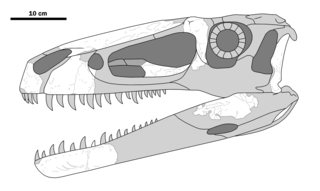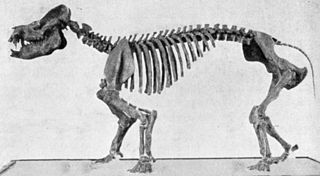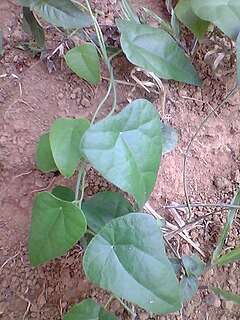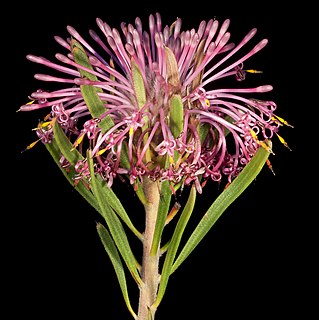
Rooibos, meaning "red bush"; is a broom-like member of the plant family Fabaceae that grows in South Africa's fynbos.

The rove beetles are a family (Staphylinidae) of beetles, primarily distinguished by their short elytra that typically leave more than half of their abdominal segments exposed. With roughly 63,000 species in thousands of genera, the group is currently recognized as the largest extant family of organisms. It is an ancient group, with fossilized rove beetles known from the Triassic, 200 million years ago, and possibly even earlier if the genus Leehermania proves to be a member of this family. They are an ecologically and morphologically diverse group of beetles, and commonly encountered in terrestrial ecosystems.

Mirabilis is a genus of plants in the family Nyctaginaceae known as the four-o'clocks or umbrellaworts. The best known species may be Mirabilis jalapa, the plant most commonly called four o'clock.

Eugenia is a genus of flowering plants in the myrtle family Myrtaceae. It has a worldwide, although highly uneven, distribution in tropical and subtropical regions. The bulk of the approximately 1,100 species occur in the New World tropics, especially in the northern Andes, the Caribbean, and the Atlantic Forest of eastern Brazil. Other centers of diversity include New Caledonia and Madagascar. Many of the species that occur in the Old World have received a new classification into the genus Syzygium.

Valdosaurus is a genus of bipedal herbivorous iguanodont ornithopod dinosaur found on the Isle of Wight and elsewhere in England, Spain and possibly also Romania. It lived during the Early Cretaceous.

Eotyrannus is a genus of tyrannosauroid theropod dinosaur hailing from the Early Cretaceous Wessex Formation beds, included in Wealden Group, located in the southwest coast of the Isle of Wight, United Kingdom. The remains (MIWG1997.550), consisting of assorted skull, axial skeleton and appendicular skeleton elements, from a juvenile or subadult, found in a plant debris clay bed, were described by Hutt et al. in early 2001. The etymology of the generic name refers to the animals classification as an early tyrannosaur or "tyrant lizard", while the specific name honors the discoverer of the fossil.

Ornithodesmus is a genus of small, dromaeosaurid dinosaur from the Isle of Wight in England, dating to about 125 million years ago. The name was originally assigned to a bird-like sacrum, initially believed to come from a bird and subsequently identified as a pterosaur. More complete pterosaur remains were later assigned to Ornithodesmus, until recently a detailed analysis determined that the original specimen in fact came from a small theropod, specifically a dromaeosaur. All pterosaurian material previously assigned to this genus has been renamed Istiodactylus.

Coryphodon is an extinct genus of mammal.

Varian, Inc. was one of the largest manufacturers of scientific instruments for the scientific industry. They had offerings over a broad range of chemical analysis equipment, with a particular focus on Information Rich Detection and Vacuum technology. Varian was spun off from Varian Associates in 1999 and was purchased by Agilent Technologies in May 2010 for $1.5 billion, or $52 per share.

Tephrosia is a genus of flowering plants in the pea family, Fabaceae. It is widespread in both the Eastern and Western Hemisphere, where it is found in tropical and warm-temperate regions.

Persoonia linearis, commonly known as the narrow-leaved geebung, is a shrub native to New South Wales and Victoria in eastern Australia. It reaches 3 m (9.8 ft), or occasionally 5 m (16 ft), in height and has thick, dark grey papery bark. The leaves are, as the species name suggests, more or less linear in shape, and are up to 9 cm (3.5 in) long, and 0.1 to 0.7 cm wide. The small yellow flowers appear in summer, autumn and early winter, followed by small green fleshy fruit known as drupes. Within the genus Persoonia, it is a member of the Lanceolata group of 58 closely related species. P. linearis interbreeds with several other species where they grow together.
Conomitra is a genus of plant in the family Apocynaceae first described in 1839. It contains only one known species, Conomitra linearis, native to Africa, from Niger to Somalia.
Lygisma is a plant genus in the family Apocynaceae, first described as a genus in 1883. It is native to southern China, Indochina, Malaysia, and the Himalayas.
- Lygisma angustifolia(Wight) Hook.f. - Himalayas
- Lygisma flavum(Ridl.) Kerr - Peninsular Malaysia
- Lygisma inflexum(Costantin) Kerr - Vietnam, Guangdong, Guangxi, Hainan
- Lygisma nervosumKerr - Thailand

Glossonema is a plant genus in the family Apocynaceae, first described as a genus in 1838. It is native to Africa and Southwest Asia.
- Glossonema boveanum(Decne.) Decne. - Yemen, NE Africa
- Glossonema revoiliiFranch. - tropical Africa
- Glossonema thruppiiOliv. - Somalia
- Glossonema varians(Stocks) Benth. ex Hook.f. - Iran, Pakistan
Pentatropis is a genus of plants in the family Apocynaceae, first described as a genus in 1834. It is native to Africa and southern Asia.

Rhyncharrhena is a genus of plants in the Apocynaceae first described as a genus in 1859 by Ferdinand von Mueller. It contains only one known species, Rhyncharrhena linearis, native to Australia, which is found in all mainland states and territories.
Pentasachme is a species of plants in the Apocynaceae first described as a genus in 1834. It contains only one recognized species, Pentasachme caudatum, native to southern China, the Indian Subcontinent, and Southeast Asia.

Cyclea is a genus of flowering plants in the family Menispermaceae.

Isopogon linearis is a small shrub in the family Proteaceae that is endemic to the southwest of Western Australia.













